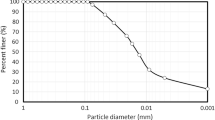Abstract
Using various additives has been considered as one of the most common stabilization methods for improvement of engineering properties of fine-grained soils. In this research the effect of sewage sludge ash (SSA) and hydrated lime (HL) on compressive strength of clayey soil was investigated. For this purpose, 16 kinds of mixtures or treatments were made by adding different amounts of SSA; 0, 5, 10 and 15% by weight and HL; 0, 1, 3 and 5% by weight of a clayey soil. First, compaction characteristics of the treatments were determined using Harvard compaction test apparatus. So that, 12 unconfined compressive strength test specimens were made using Harvard compaction mold from each treatments taking into account four different curing ages, including 7, 14, 28 and 90 days in three replications. Therefore, a total of 192 specimens were prepared and subjected to unconfined compressive strength tests. The results of this study showed that the maximum dry density of the treated soil samples decreases and their optimum water content increases by increasing the amount of SSA and hydrated lime in the mixtures. It is also found that the adding of HL and SSA individually would increase the compressive strength up to 3.8 and 1.5 times respectively. The application of HL and SSA with together could increases the compressive strength of a clayey soil more efficiently even up to 5 times.













Similar content being viewed by others
References
Abbasi N, Nazifi MH (2013) Assessment and modification of sherard chemical method for evaluation of dispersion potential of soils. J Geotech Geol Eng 31(1):337–349. https://doi.org/10.1007/s10706-012-9573-7
Abbasi N, Farjad A, Sepehri S (2017) The use of nanoclay particles for stabilization of dispersive clayey soils. J Geotech Geol Eng. https://doi.org/10.1007/s10706-017-0330-9
ASTM D 4609-00 (2000) Standard Guide for Evaluating Effectiveness of Admixtures for Soil Stabilization. Annual book of ASTM standards. American Society for Testing and Materials, Philadelphia, sec. 4, vol 04-08, pp 10–16. www.astm.org
ASTM D 422-63 (2007) Standard Test Method for Particle Size Analysis of Soils. Annual book of ASTM standards. American Society for Testing and Materials, Philadelphia, sec. 4, vol 04-08, pp 10–16. www.astm.org
ASTM D 2166-00 (2000) Standard Test Method for Unconfined Compressive Strength of Cohesive Soil. Annual book of ASTM standards. American Society for Testing and Materials, Philadelphia, sec. 4, vol 04-08, pp 10–16. www.astm.org
ASTM D 4318-10 (2000) Standard Test Methods for Liquid Limit, Plastic Limit, and Plasticity Index of Soils. Annual book of ASTM standards, American Society for Testing and Materials, Philadelphia, sec. 4, vol 04-08, pp 10–16. www.astm.org
Bowles JE (1992) Engineering properties of soils and their measurement, 4th edn. McGraw-Hill, New York, p 241
Chen L, Lin DF (2009) Stabilization treatment of soft subgrade soil by sewage sludge ash and cement. J Hazard Mater 162:321–327
Lin DF, Lin KL, Hung MJ, Luo HL (2007) Sludge ash/hydrated lime on the geotechnical properties of soft soil. J Hazard Mater 145:58–64
Maaitah O (2012) Soil stabilization by chemical agent. Geotech Geol Eng 30:1345–1356
Pradhan PK, Sahoo JDP (2010) Effect of lime stabilized soil cushion on strength behavior of expansive soil. Geotech Geol Eng 28:889–897
Rahimi H, Abbasi N (2007) Failure of concrete canal lining on fine sandy soils: a case study for the Saveh Project. J Irrig Drain Eng 57:83–92. https://doi.org/10.1002/ird.350
Rahimi H, Abbasi N, Shantia H (2011) Application of geomembrane to control piping of sandy soil under concrete canal lining (case study: Moghan irrigation project, Iran). J Irrig Drain Eng 60:330–337. https://doi.org/10.1002/ird.574
Sakr MA, Shahin MA, Metwally YM (2009) Utilization of lime for stabilizing soft clay soil of high organic content. Geotech Geol Eng 27:105–113
Seco A, Ramírez F, Miqueleiz L, García B (2011) Stabilization of expansive soils for use in construction. Appl Clay Sci 51:348–352
Tempest QB, Pando MA (2013) Characterization and demonstration of reuse applications of sewage sludge ash. Int J Geomate 4:552–559
Yilmaz I, Civelekoglu B (2009) Gypsum: an additive for stabilization of swelling clay soils. Appl Clay Sci 4:166–172
Acknowledgements
This research has been carried out in the laboratories of soil mechanics and construction materials in Tak Azmaye Zanjan Consulting Company, Iranian agricultural engineering research Institute and Sanaye Mese Novin Company. The authors hereby express their thanks to the staff and management of the mentioned companies and institute.
Author information
Authors and Affiliations
Corresponding author
Rights and permissions
About this article
Cite this article
Norouzian, K., Abbasi, N. & Abedi Koupai, J. Use of Sewage Sludge Ash and Hydrated Lime to Improve the Engineering Properties of Clayey Soils. Geotech Geol Eng 36, 1575–1586 (2018). https://doi.org/10.1007/s10706-017-0411-9
Received:
Accepted:
Published:
Issue Date:
DOI: https://doi.org/10.1007/s10706-017-0411-9




